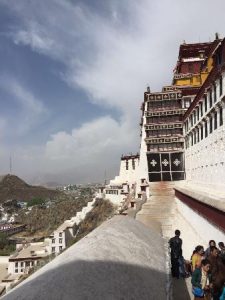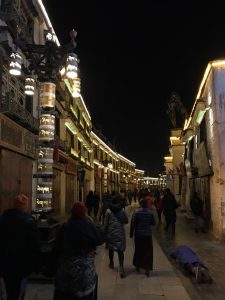 The Barkhor Street is an important passage for Tibetan Buddhist monks and believers to worship and pray. The Barkhor Street is surrounded by the Jokhang Temple. It is a concentrated version of Tibet’s history, religion, folk customs and trade. If you don’t go to the Barkhor Street, you cannot see the Jokhang Temple; if you don’t go to the Barkhor Street, as if you have not been to Lhasa; a lot of people feel that the Barkhor Street before dawn is the purest, the strong religious atmosphere makes people moved! In Barkhor Street, you can taste food from Tibet, India, Nepal, etc.; buy jewelry and ethnic handicrafts; observe and experience unique Tibetan folk customs and cultures nearby; it is an ideal place for sightseeing and worshipping Buddha.
The Barkhor Street is an important passage for Tibetan Buddhist monks and believers to worship and pray. The Barkhor Street is surrounded by the Jokhang Temple. It is a concentrated version of Tibet’s history, religion, folk customs and trade. If you don’t go to the Barkhor Street, you cannot see the Jokhang Temple; if you don’t go to the Barkhor Street, as if you have not been to Lhasa; a lot of people feel that the Barkhor Street before dawn is the purest, the strong religious atmosphere makes people moved! In Barkhor Street, you can taste food from Tibet, India, Nepal, etc.; buy jewelry and ethnic handicrafts; observe and experience unique Tibetan folk customs and cultures nearby; it is an ideal place for sightseeing and worshipping Buddha.
Barkhor Street is the second place to that must be visited in addition to the Potala Palace, for your Lhasa trip. It is also the way for the locals to worship. There are very few people stopping to watch the worshippers, except for a few tourists, it maybe because people are used to it, and regard this as part of life. There is a famous restaurant in the Barkhor Street, called Makye Ame, and there are really many people in the restaurant, and the price is more expensive. However, it is a good place to learn about the lives of local people.
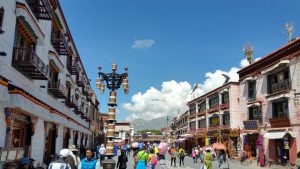 Everyone who enters Barkhor Street and Jokhang Temple Square needs to pass the security check, scan the ID card, check the backpack before entering, and Barkhor Street is a place worth visiting. It is not only near the Jokhang Temple, and it is the most prosperous place in Lhasa. It is surrounded by a lot of sweet tea shops, restaurants, western food, so you can experience the local style. As for the time of play, it can be 1 hour or half a day, all depending on your needs. Because there are many lanes, you can go deep to experience more there.
Everyone who enters Barkhor Street and Jokhang Temple Square needs to pass the security check, scan the ID card, check the backpack before entering, and Barkhor Street is a place worth visiting. It is not only near the Jokhang Temple, and it is the most prosperous place in Lhasa. It is surrounded by a lot of sweet tea shops, restaurants, western food, so you can experience the local style. As for the time of play, it can be 1 hour or half a day, all depending on your needs. Because there are many lanes, you can go deep to experience more there.

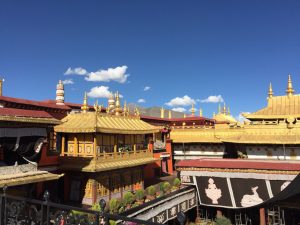 The Jokhang Temple is a true sacred place in the hearts of millions of Tibetan believers and has supreme status in Tibetan Buddhism. In particular, the devout worshippers who are in front of the temple really will let you feel the power of faith. The Jokhang Temple, located in the center of the old city of Lhasa, Tibet Autonomous Region, is a Tibetan Buddhist monastery and the earliest civil structure in Tibet. It is recommended to ask a guide to explain more deeply. Photographs can be taken outside the temple, but taking photos is prohibited in the main hall. The golden dome of the Jokhang Temple is shining, which cost more than 40 million to build! Numerous gold and bronze sculptures are vivid and beautiful, and the Potala Palace can be seen from the terrace on the second floor of the Jokhang Temple. The ticket for the Jokhang Temple during the peak season is 85 yuan / person, in addition to the Jokhang Temple, the ticket-free attractions also include the Potala Palace, Everest, Lake Nam, and other district-level tourist attractions!
The Jokhang Temple is a true sacred place in the hearts of millions of Tibetan believers and has supreme status in Tibetan Buddhism. In particular, the devout worshippers who are in front of the temple really will let you feel the power of faith. The Jokhang Temple, located in the center of the old city of Lhasa, Tibet Autonomous Region, is a Tibetan Buddhist monastery and the earliest civil structure in Tibet. It is recommended to ask a guide to explain more deeply. Photographs can be taken outside the temple, but taking photos is prohibited in the main hall. The golden dome of the Jokhang Temple is shining, which cost more than 40 million to build! Numerous gold and bronze sculptures are vivid and beautiful, and the Potala Palace can be seen from the terrace on the second floor of the Jokhang Temple. The ticket for the Jokhang Temple during the peak season is 85 yuan / person, in addition to the Jokhang Temple, the ticket-free attractions also include the Potala Palace, Everest, Lake Nam, and other district-level tourist attractions!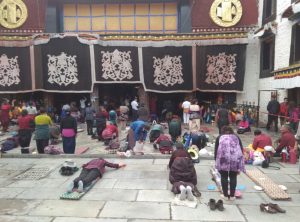
 As the largest temple in the world, Drepung Monastery has a maximum of more than 10,000 people, and the tour there takes about 3 to 4 hours. There are countless halls in Drepung Monastery, the most famous of which are the Gandan PoZhang Hall (5th Dalai Palace) and the Cuoqin Hall.
As the largest temple in the world, Drepung Monastery has a maximum of more than 10,000 people, and the tour there takes about 3 to 4 hours. There are countless halls in Drepung Monastery, the most famous of which are the Gandan PoZhang Hall (5th Dalai Palace) and the Cuoqin Hall.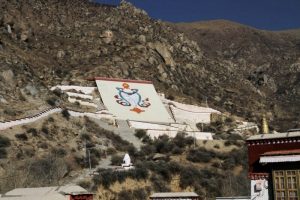
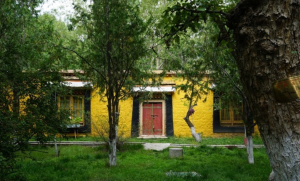 Norbulingka is located on the west side of the Potala Palace. It was built in the 1840s (Dalai VII) and is a place where the Dalai Lama has spent the summer there to deal with government affairs (it is called summer palace). It is a typical Tibetan style garden. The Norbulingka is quite large and covers an area of 360,000 square meters. It consists of several groups of palace buildings, such as Gesangpozhang, Jinse Pozhang, and Dadan Mingjiuzhang. Among them, the Cuoji Pozhang (Huxin Pavilion) is the most beautiful scenic spot in the Norbulingka. “Da Dan Ming Wen Pozhang” is the new palace of the 14th Dalai Lama. The Tibetan language means “the eternal palace.” It is truly magnificent, and full of flowers! However, photographs are not allowed inside the palace. There are many Thangkas and countless treasures, and one of the gold thrones made of pure gold is staggering!
Norbulingka is located on the west side of the Potala Palace. It was built in the 1840s (Dalai VII) and is a place where the Dalai Lama has spent the summer there to deal with government affairs (it is called summer palace). It is a typical Tibetan style garden. The Norbulingka is quite large and covers an area of 360,000 square meters. It consists of several groups of palace buildings, such as Gesangpozhang, Jinse Pozhang, and Dadan Mingjiuzhang. Among them, the Cuoji Pozhang (Huxin Pavilion) is the most beautiful scenic spot in the Norbulingka. “Da Dan Ming Wen Pozhang” is the new palace of the 14th Dalai Lama. The Tibetan language means “the eternal palace.” It is truly magnificent, and full of flowers! However, photographs are not allowed inside the palace. There are many Thangkas and countless treasures, and one of the gold thrones made of pure gold is staggering!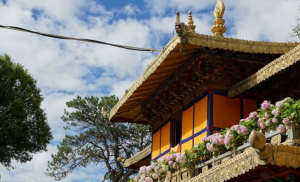
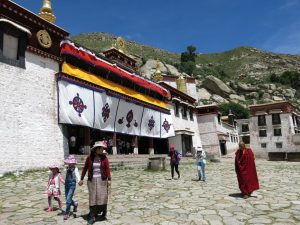 Sera Monastery is located in the northern suburbs of Lhasa. It costs about 40 yuan when going there from the city. The Tibetans in the scenic area are free to open. Tickets for other tourists are 50 Yuan/person.
Sera Monastery is located in the northern suburbs of Lhasa. It costs about 40 yuan when going there from the city. The Tibetans in the scenic area are free to open. Tickets for other tourists are 50 Yuan/person.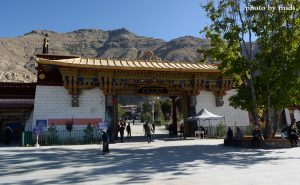
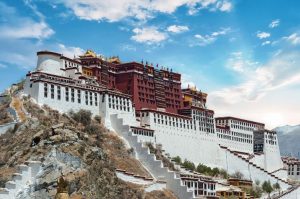 The Potala Palace is very close to the Jokhang Temple. It is 20 minutes from the Jokhang Temple. It is a place for taking pictures. There are many believers kowtowing in the door of the palace.
The Potala Palace is very close to the Jokhang Temple. It is 20 minutes from the Jokhang Temple. It is a place for taking pictures. There are many believers kowtowing in the door of the palace.